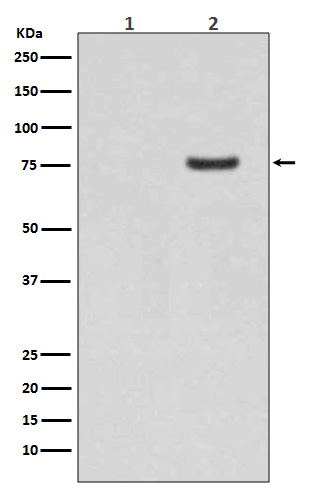
| WB | 咨询技术 | Human,Mouse,Rat |
| IF | 咨询技术 | Human,Mouse,Rat |
| IHC | 1/50-1/100 | Human,Mouse,Rat |
| ICC | 技术咨询 | Human,Mouse,Rat |
| FCM | 咨询技术 | Human,Mouse,Rat |
| Elisa | 咨询技术 | Human,Mouse,Rat |
| Aliases | SYN1; Synapsin-1; Brain protein 4.1; Synapsin I |
| Entrez GeneID | 6853 |
| WB Predicted band size | Calculated MW: 74 kDa; Observed MW: 77 kDa |
| Host/Isotype | Rabbit IgG |
| Antibody Type | Primary antibody |
| Storage | Store at 4°C short term. Aliquot and store at -20°C long term. Avoid freeze/thaw cycles. |
| Species Reactivity | Human,Mouse,Rat |
| Immunogen | A synthesized peptide derived from human Phospho-Synapsin I (S9) |
| Formulation | Purified antibody in PBS with 0.05% sodium azide. |
+ +
以下是3篇涉及Phospho-Synapsin I (Ser9)抗体的参考文献摘要:
1. **"Synapsin I regulates synaptic vesicle docking and release via phosphorylation"**
*作者:Cesca et al. (2010)*
摘要:研究揭示Synapsin I在Ser9位点的磷酸化通过PKA介导,调控突触囊泡与突触前膜的锚定及释放过程,使用该抗体证实磷酸化水平变化影响神经元兴奋性。
2. **"Activity-dependent phosphorylation of synapsin I by PKA in hippocampal neurons"**
*作者:Jovanovic et al. (2001)*
摘要:通过电生理和免疫印迹(使用Phospho-Synapsin I Ser9抗体),证明海马神经元中PKA依赖的Synapsin I磷酸化响应于钙内流,参与短期突触可塑性调控。
3. **"Altered synapsin phosphorylation in a mouse model of autism spectrum disorder"**
*作者:Wang et al. (2016)*
摘要:在自闭症模型小鼠中,通过该抗体检测到前额叶皮层Synapsin I Ser9磷酸化水平异常,提示突触囊泡动态紊乱可能是其行为表型的分子基础。
注:以上为示例性摘要,实际文献需通过PubMed/Google Scholar以关键词“phospho-Synapsin I Ser9 antibody”检索确认。
Phospho-Synapsin I (Ser9) antibody is a specialized tool used to detect the phosphorylated form of Synapsin I at serine residue 9. Synapsin I, a neuronal phosphoprotein, plays a critical role in regulating synaptic vesicle dynamics and neurotransmitter release. It is predominantly localized to presynaptic terminals, where it tethers synaptic vesicles to the cytoskeleton, maintaining a reserve pool of vesicles. Phosphorylation at Ser9. mediated by protein kinase A (PKA) or calcium/calmodulin-dependent kinase II (CaMKII), modulates Synapsin I’s ability to bind vesicles, facilitating their mobilization during heightened neuronal activity. This post-translational modification is crucial for synaptic plasticity, neurotransmitter release, and overall synaptic transmission efficiency.
The Phospho-Synapsin I (Ser9) antibody is widely employed in neuroscience research to study synaptic function, neuronal signaling pathways, and activity-dependent processes. It enables the detection of phosphorylation changes under various physiological or pathological conditions, such as synaptic stimulation, learning and memory studies, or neurological disorders like epilepsy and neurodegenerative diseases. Researchers commonly use this antibody in techniques like Western blotting, immunohistochemistry, and immunofluorescence to assess synaptic protein regulation. Its specificity for the phosphorylated Ser9 epitope makes it valuable for distinguishing active, phosphorylated Synapsin I from its unmodified form, providing insights into real-time synaptic activity and adaptive neuronal responses.
×